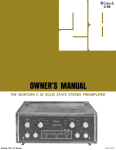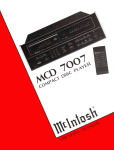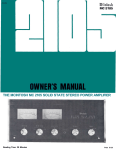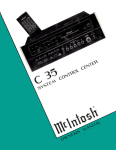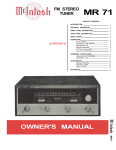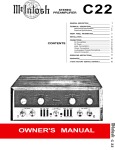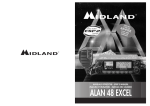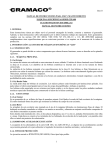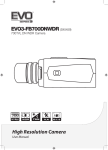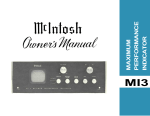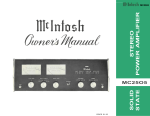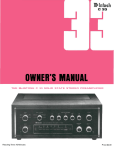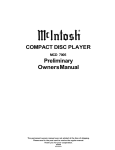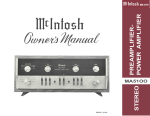Download THE McINTOSH C27 SOLID STATE STEREO
Transcript
THE McINTOSH C27 SOLID STATE STEREO PREAMPLIFIER Reading Time: 28 Minutes Price: $2-00 WARNING: TO PREVENT FIRE OR SHOCK HAZARD, DO NOT EXPOSE THIS UNIT TO RAIN OR MOISTURE. The Mclntosh you have purchased has a serial number located on the rear panel of the chassis. Record that serial number here for future references. The model and serial number are important to you for any future service. Your C 27 Stereo Preamplifier will give you many years of pleasant and satisfactory performance. If you have any questions, please contact: Contents SERVICE CONTRACT . . . . 1 CUSTOMER SERVICE INTRODUCTION . . . . 2 Mclntosh Laboratory Inc. 2 Chambers Street Binghamton, New York 13903 Phone: 607-723-3512 HOW TO INSTALL . . . . HOW TO CONNECT . . . . 2 4 WHAT THE FRONT PANEL CONTROLS AND HOW TO USE THEM . . . . 8 BALANCING YOUR STEREO . . . . 11 P E R F O R M A N C E LIMITS AND RATINGS . . . . 12 P E R F O R M A N C E CHARTS . . . . 13 Take Advantage of 3 years of FREE Service . . . Fill in the Application NOW. TECHNICAL DESCRIPTION . . . . 14 BLOCK DIAGRAM . . . . 15 THREE YEAR SERVICE CONTRACT An application for a FREE THREE YEAR SERVICE CONTRACT is included with this manual. The terms of the contract are: 1. Mclntosh will provide ail parts, materials and labor needed to return the measured performance of the instrument to the original performance limits free of any charge. The SERVICE CONTRACT does not cover any shipping costs to and from the authorized service agency or the factory. 2. Any Mclntosh authorized service agency will repair all Mclntosh instruments at normal service rates. To receive the free service under the terms of the SERVICE CONTRACT, the SERVICE CONTRACT CERTIFICATE must accompany the instrument when taken to the service agency. 3. Always have service done by a Mclntosh authorized service agency. If the instrument is modified or damaged, as a result of unauthorized repair the SERVICE CONTRACT will be cancelled. Damage by improper use or Copyright © 1977 by Mclntosh Laboratory Inc. mishandling is not covered by the SERVICE CONTRACT. 4. The SERVICE CONTRACT is issued to you as the original purchaser. To protect you from misrepresentation this contract cannot be transferred to a second owner. 5. For your protection Mclntosh selects only dealers who have technical competence to guide purchasers fairly, and provide service when necessary. To receive the SERVICE CONTRACT your purchase must be made from a Mclntosh franchised dealer. 6. Your completely filled in application for a SERVICE CONTRACT must be postmarked within 30 days of the date of purchase of the instrument. 7. To receive the SERVICE CONTRACT all information on the application must be filled in. The SERVICE CONTRACT will be issued when the completely filled in application is received at Mclntosh Laboratory Incorporated in Binghamton, New York. How to Connect CONNECTING A TURNTABLE TO PHONO 1 Connect the cable from the "left" channel of the turntable into the L PHONO 1 INPUT jack. CONNECTING A STEREO TUNER Connect the cable from the "left" channel tuner output to the L TUNER INPUT jack. Connect the cable from the "right" channel of the turntable into the R PHONO 1 INPUT jack. Connect the cable from the "right" channel tuner output to the R TUNER INPUT jack. PHONO 2 is provided for the use of a second turntable. AUX—Any high level program source such as a tuner, a TV set or a tape recorder can be connected to the AUX 1 and 2 INPUT jacks. The connecting procedure is the same as for the tuner input. Connect the cable from the "left" channel of the turntable into the L PHONO 2 INPUT jack. Connect the cable from the "right" channel of the turntable into the R PHONO 2 INPUT jack. CONNECTING TAPE RECORDERS To Record: Connect a cable from the L TAPE 1 OUTPUT jack to the left high level input of the tape recorder. Plug the AC power cable from the turntable into the red unswitched POWER outlet on the rear panel. The red receptacle is on at all times. It is necessary to turn off the turntable with its own AC power switch. This arrangement protects the turntable. Connect a cable from the R TAPE 1 OUTPUT jack to the right high level input of the tape recorder. Connect a second recorder in the same manner to the TAPE 2 OUTPUT jacks. The four black AC power outlets are controlled by the front panel POWER switch. Use these outlets for a tuner, tape recorder, etc. To Playback/Monitor: Connect a cable from the left channel output of a tape recorder to the L TAPE 1 INPUT jack. GROUND CONNECTION A single ground post is provided. Grounds for turntables, record changers, tape decks, etc. are to be connected to this post. The left and right program cables and the ground wire from that source should be wound or twisted together. To avoid hum make sure the ground wire does not make any connections to the shields of the left and right program cables between the program source and the C 27. Connect a cable from the right channel output of a tape recorder to the R TAPE 1 INPUT jack. Connect a second recorder in the same manner to the TAPE 2 INPUT jacks. 4 FM ANTENNA TUNER TURNTABLE #1 TURNTABLE #2 AC POWER TO TURNTABLES AC POWER TO TUNERS, TAPE RECORDERS AND POWER AMPLIFIERS TAPE RECORDER 1 CONNECTIONS FOR TUNERS, TURNTABLES, AND TAPE RECORDERS 5 TAPE RECORDER 2 POWER AMPLIFIER LOUDSPEAKER ENVIRONMENTAL EQUALIZER SPEAKER SYSTEM #1 S P E A K E R SYSTEM #2 CONNECTIONS FOR POWER AMPLIFIER AND LOUDSPEAKERS 6 Connect a wire from the proper impedance output connection on the power amplifier to the FROM AMPLIFIER push connectors on the C 27 rear panel. Connect the first pair of speakers to the rear panel SPEAKER 1 push connectors and a second pair of speakers to the SPEAKER 2 push connectors. When connecting the speakers and power amplifier it is important to connect the power amplifier output impedance tap for the parallel impedance combination of the two speaker systems used. The front panel SPEAKER switch permits routing program to either SPEAKER 1, SPEAKER 2, both 1 and 2, or OFF. In the SPEAKER OFF position, the program is fed only to the HEADPHONE jack for private listening. CONNECTING THE C 27 TO POWER AMPLIFIERS Connect the MAIN OUTPUT jacks to the input of a stereo power amplifier. The Left MAIN jack is connected to the left amplifier input jack. The Right MAIN jack is connected to the right amplifier input jack. A second pair of MAIN OUTPUT jacks have been supplied to feed a second power amplifier. In the event it is desired to tape record after the tone filter and volume controls the second set of MAIN OUTPUT jacks can be connected to the tape recorder input. The controls are then all available to alter the signal before recording. Remember, any change in the setting of the controls will change the program to the tape recorder. Since the recording signal available at the MAIN OUTPUT is much higher than the output available from the TAPE 1 or TAPE 2 OUTPUT jacks, be sure not to overload the tape recorder input. It will not be possible to monitor from the tape recorder via the TAPE MONITOR pushbuttons while feeding the recorder from the MAIN OUTPUT jacks. Depressing the TAPE MONITOR pushbutton will disconnect the program source and may cause feedback oscillation. AC OUTLETS There are 4 black AC outlets and one red AC outlet. The power to the black AC outlets is controlled by the front panel AC power switch. Use these outlets for a tuner, tape recorder, etc. The total capacity of all AC power outlets is 600 watts. The red receptacle is on at all times to feed AC power to a turntable so that it can be turned on or off with its own AC switch. Cables are supplied with the C 27 to interconnect to the power amplifier. Longer cables can be used if needed. The length of the cable is limited by the capacity of the cable. The total capacity must not exceed 1,000 pF. For instance: cables with a capacity of 25 pF per foot may be 40 feet long. 13.5 pF per foot cable may be 75 feet long. The input impedance of the amplifiers should be 22k ohms or greater. FUSE A 0.5 AMP fuse protects the preamplifier circuits. The fuse does not protect additional equipment connected to the back panel AC outlets. CTR CHAN Use the CenTeR CHANnel output to feed left plus right signal to a separate power amplifier for monophonic background music or for a center channel. CONNECTING FOR SPEAKER SWITCHING AND HEADPHONE When the power amplifier output is properly connected to the rear panel FROM AMPLIFIER push connectors, speakers in two separate areas can be turned on or off and the C 27 front panel HEADPHONE jack will receive the program signal. 7 What the Front Panel controls Do and How to use Them INPUT SELECTOR speakers. Stereo Rev: Connects the left input to the right loudspeaker and the right input to the left loudspeaker. The INPUT SELECTOR is a five position switch that connects the chosen input program to the proper circuits in the C 27. Stereo: Connects the left input to the left loudspeaker and the right input to the right loudspeaker. AUX 1: Connects to the high level input, any output from a high level program source requiring flat amplification. Such a source could be a television set, playback from another tape recorder, an additional tuner, etc. In the AUX 1 position the gain is 20 dB to the MAIN outputs, 0 dB to the TAPE outputs. The input impedance is 100 k ohms. Mono (L + R): Adds the left input and the right input and then connects the L + R program to both loudspeakers. L + R to L: Adds the left and right program together and connects the combined program to the left loudspeaker only. AUX 2: Same as AUX 1 but for a second high level program source. L + R to R: Adds the left and right program together and connects the combined program to the right loudspeaker only. TUNER: Connects the output from any AM, FM or MPX FM tuner to the high level input stage. In the TUNER position the C 27 has flat amplification. There is 20 dB of gain to the MAIN outputs, 0 dB to the TAPE outputs. The input impedance is 100k ohms. PRECISE TRACKING VOLUME CONTROL The VOLUME control is a precision step attenuator which has left to right tracking accuracy within 1 dB throughout its entire range. Such extremely accurate matching is achieved through electronically controlled trimming of the resistance material deposited on pairs of printed circuits. Since the switch commutator touches only contact pads and not the actual resistance element, tracking acc u r a c y is not degraded with use as in ordinary volume controls. Clockwise rotation increases volume. The VOLUME control in the C 27 has been designed and manufactured for Mclntosh Laboratory. PHONO 1: Connects the output of any magnetic phono cartridge to the low level input stage. The response has been shaped according to the RIAA standard to compensate for the characteristics of a magnetic phono cartridge. The gain at 1K Hz is 62 dB to the MAIN outputs, 42 dB to the TAPE outputs. The input impedance is 47k ohms and 100 pF. PHONO 2: Same as PHONO 1 but for a second phono system. FILTERS/SPEAKERS The small center knob of the concentric FILTER/ SPEAKERS control shapes the C 27 frequency response to reduce or filter objectionable low frequency noise and/or objectionable high frequency noise. The large outer knob MODE SELECTOR L to L & R: Connects the left input to both loudspeakers. R to L & R: Connects the right input to both loud- 8 will turn main or remote loudspeakers on or off when a power amplifier has been properly connected to the C 27 rear panel. Right: Has the same effect on the sound from the right loudspeaker. TREBLE Concentric, 11 position, tone control switches adjust the treble. The outer knob adjusts the right channel response. The center knob adjusts the left channel treble response. FILTER OPERATION OUT: Filter disconnected, program not modified by either high or low frequency filters. LF (LOW FREQUENCY FILTER) Use the LF position to reduce objectionable lowfrequency noise created by a turntable or record changer or acoustically coupled feedback. Response is rolled off below 50 Hz. Left: Adjusts the treble loudness from the left loudspeaker. Clockwise rotation increases the treble loudness while counterclockwise rotation decreases the treble loudness. Each step of the tone control adjusts the treble loudness about 4 dB. HF (HIGH FREQUENCY FILTER) Use the HF position to reduce objectionable highfrequency noise such as record scratch. Response is rolled off above 5,000 Hz. Right: Has the same effect on the sound from the right loudspeaker. LOUD/BALANCE LOUDNESS: Use the loudness control for full frequency range listening at even the softest listening levels. The LOUDness control (the small center knob of the concentric control) provides low-frequency boost to compensate for a hearing characteristic of the human ear at low listening levels. The ear becomes less sensitive to low frequencies as volume is reduced. Increased loudness compensation is therefore desirable at lower listening levels. The loudness control boosts the low frequencies so that the ear hears approximately the same musical balance as it would at higher listening levels. LF-HF Both high and low frequency filters are activated. SPEAKERS OPERATION OUT: All speakers are disconnected. Program is fed only to the HEADPHONE jack for private listening. 1: Program is fed only to the rear panel SPEAKER 1 connectors and the HEADPHONE jack. SPEAKER 2 is disconnected. 1 & 2: Program is fed to the rear panel SPEAKER 1 and 2 connectors and the HEADPHONE jack. 2: Program material is fed only to the rear panel SPEAKER 2 connectors and the HEADPHONE JACK. SPEAKER 1 is disconnected. FLAT: (Maximum counterclockwise rotation) Full volume with flat frequency response. The loudness compensation is inoperative in this position. Turning the control clockwise toward MAX reduces the listening volume, and automatically increases the compensation by boosting bass. BASS Concentric, 11 position, tone control switches adjust the bass. The outer knob adjusts the right channel bass response. The center knob adjusts the left channel bass response. BALANCE The BALANCE control adjusts for unequal volume in either the left or right channels. The volume of the channels can be varied relative to each other without affecting their combined volume. Left: Adjusts the bass loudness from the left loudspeaker. Clockwise rotation increases the bass loudness while counterclockwise rotation decreases the bass loudness. Each step of the tone control adjusts the bass loudness about 4 dB. Turning the control to the left accents the left channel 9 by reducing the right channel output and turning the control to the right accents the right channel by reducing the left channel output. TAPE 2 MONITOR A second tape recorder can be operated in the same manner using pushbutton TAPE 2 MONITOR. PANLOC Depressing the two PANLOC buttons on the front panel permits the C 27 to be either locked firmly in place or unlocked so that the chassis can be slid forward, until it is stopped by the mid-position latches. Press the latches on the side of the C 27 inward to permit the instrument to slide in or out of the cabinet. With the C 27 front panel flush with the cabinet panel, pressing the PANLOC buttons will lock the unit firmly in the cabinet. Use the front panel pushbutton TAPE 2 to playback from a tape recorder plugged into the rear panel TAPE 2 INPUT jacks. HOW TO COPY TAPE, TAPE COPY 1 -> 2 Put the tape to be copied on the recorder connected to TAPE 1 INPUT. Press in the TAPE COPY 1 -> 2 pushbutton. The signal available at the TAPE 2 OUTPUT jacks is the playback of TAPE 1. Record on the recorder connected to TAPE 2 OUTPUT. The source tape on tape recorder 1 can be heard by pressing in the TAPE 1 MONITOR pushbutton. The recording can be monitored by pressing in the TAPE 2 MONITOR pushbutton. Instantaneous comparison on the recorded program with the original can be heard. THE PUSHBUTTONS The C 27 is designed to be used with one or two tape recorders. The front panel pushbuttons permit normal playback of either recorder, monitor as recordings are being made on either recorder, or copying tapes from one recorder to another while listening to a separate program. TAPE COPY 2 -> 1 When pushed IN the TAPE 2 OUTPUT jacks are connected to the TAPE 1 INPUT jacks without affecting the program heard from the speakers. In this position a copy of the program on tape recorder 2 can be made on tape recorder 1. TAPE MONITOR To monitor while recording from any source chosen on the INPUT SELECTOR, your tape recorder must have separate record and playback heads and separate electronics. The MONITOR switches let you monitor the quality of tape recordings made during the recording process. When the chosen TAPE MONITOR pushbutton is in the IN position the sound from the tape as it passes the playback head is heard a moment after it is recorded. The recording process continues as usual. When the switch is in the OUT position, the program that is being recorded is heard. To monitor the tape copy procedures use the TAPE MONITOR pushbuttons. POWER The POWER switch energizes the C 27 circuits and connects AC power to the black rear panel AC power outlets. The black AC power outlets are not fused. A lighted rectangle above the ON POWER switch indicates the AC power to the system is turned on. TAPE 1 MONITOR PUSHBUTTON OUT . . . The program source selection by the INPUT SELECTOR is fed to the power amplifiers and heard through the loudspeakers. HEADPHONES The front panel HEADPHONE jack has been designed to feed low impedance dynamic headphones. Electrostatic headphones generally require higher power than dynamic headphones. They must be connected to the output connectors on the power amplifier. PUSHBUTTON IN . . . The program source becomes the recorded tape on the recorder connected to TAPE 1 INPUT. The recorded program from tape recorder 1 is fed to the power amplifiers and heard from the loudspeakers. Plug headphones into the front panel HEADPHONE jack. Adjust the VOLUME control for comfortable headphone listening. The output of an external power amplifier must be properly connected to the C 27 back panel for program material to be available at the HEADPHONE jack. In the PUSHBUTTON IN position, a rectangle is lighted above the pushbutton. When the light is on only the tape will be heard. To listen to other sources the pushbutton must be out and the light off. 10 Balancing your Stereo The performance and enjoyment of a stereo system is greatly increased when the sound is properly balanced. The balance of the stereo system is affected by many things including room acoustics, furniture placement, room shape, small differences in loudspeakers etc. speakers. If there is a difference in loudness turn the BALANCE control to adjust for equal loudness. Clockwise rotation balances for lack of loudness on the right—conterclockwise balances for lack of loudness on the left, Next, set the MODE selector to STEREO. If there is then a difference in loudness turn the BALANCE control toward the speaker that is not as loud. Adjust until the sound is balanced from both speakers. TO BALANCE LOUDNESS 1. Set the MODE switch to MONO (L + R] 2. Play a familiar recording. 3. Turn the BALANCE control to the 10 o'clock position. While the program is playing, stand between the two loudspeakers. Listen for a difference in loudness between 11 Performance Limits and Ratings MOUNTING: Exclusive Mclntosh developed professional PANLOC. PERFORMANCE LIMITS are the maximum deviation from perfection permitted for a Mclntosh instrument. We promise you that your C 27 must be capable of performance at or exceeding these limits or you get your money back. Mclntosh is the only manufacturer that makes this guarantee. WEIGHT: 20 pounds (9.1 kg) net, 32 pounds (14.5 kg) in shipping carton. FACILITIES AND FEATURES BASS Separate 11 position rotary switches for each channel. -17 dB to +16 dB at 20 Hz TREBLE Separate 11 position rotary switches for each channel -20 dB to +20 dB at 20k Hz FREQUENCY RESPONSE +0 -0.5 dB 20 Hz to 20k Hz DISTORTION Will not exceed 0.05% at rated output level, 20 Hz to 20k Hz INPUT SENSITIVITY AND IMPEDANCE AUXILIARY i and 2, TUNER, TAPE 1 and 2: 250 millivolts at 100k ohms. PHONO 1 and 2: 2 millivolts at 47k ohms and 100 pF. HUM AND NOISE AUXILIARY 1 and 2, TUNER, TAPE 1 and 2: 85 dB unweighted; 90 dB IHF A weighted. PHONO 1 and 2: 80 dB below 10 mV input, unweighted; 85 dB IHF A weighted. OUTPUT LEVEL AND IMPEDANCE MAIN OUTPUT 2.5 volts with rated input, less than 1k ohms source impedance, to operate into 22k ohms load or higher. Maximum output is greater than 10 volts TAPE OUTPUT 0.25 volts with rated input, less than 1.5k ohms source impedance, to operate into 22k ohms load or higher. Maximum output is greater than 10 volts CENTER CHANNEL OUTPUT (L + R) 2.5 volts with rated input to both channels, less than 1.2k ohms source impedance, to operate into 22k ohms load or higher. VOLTAGE AMPLIFICATION IN DECIBELS AUXILIARY 1 and 2, TUNER, TAPE 1 and 2 to MAIN OUTPUT 20 dB to TAPE OUTPUT 0 dB PHONO 1 and 2 to MAIN OUTPUT 62 dB to TAPE OUTPUT 42 dB SEMICONDUCTOR COMPLEMENT 18 Silicon—Planar transistors 4 Silicon Diodes 5 Light Emitting diodes AC POWER OUTLETS 1 unswitched (Red) 4 switched POWER REQUIREMENT 120 volts, 50/60 Hz, 15 watts MECHANICAL INFORMATION SIZE: Front Panel measures 16 inches wide (40.6 cm) by 5 7/16 inches high (13.8 cm). Chassis measures 14 3/4 inches wide (37.5 cm) by 4 13/16 inches high (12.2 cm) by 13 inches deep (30.0 cm), including PANLOC shelf and back panel connectors. Knob clearance required is 1 1/4 inches (3.2 cm) in front of the mounting panel. LOUDNESS Flat response, or continuously variable loudness equalization. BALANCE Natural balance at center position, attenuation of left or right channel by rotating control VOLUME Precision step attenuator with matched elements for proper tracking at all listening levels. Does not change stereo balance as volume is changed. INPUT Five positions—AUXILIARY 1 and 2, TUNER, PHONO 1 and 2 MODE Seven positions—Left channel only to both speakers. Right channel only to both speakers, STEREO REVerse, STEREO, MONO (L + R), L + R to Left speaker only, and L + R to Right speaker only TAPE MONITOR Two pushbutton switches. Either of two tape recorders can be monitored. They are mechanically interlocked to accept only one pushbutton at the IN position at one time TAPE COPY SWITCH Two pushbutton switches. Either of two tape recorders can be connected to copy from one to the other or vice versa. They are mechanically interlocked to accept only one pushbutton at the IN position at one time. LF FILTER (Rumble Filter) Flat or roll-off 12 dB per octave below 50 Hz, down 12 dB at 20 Hz HF FILTER (Scratch Filter) Flat or roll-off 12 dB per octave above 5k Hz. down 12 dB at 20 k Hz SPEAKER SWITCH Facilities are provided to connect the power amplifier to the rear panel of the C 27 to permit switching two pairs of speakers on and off. FINISH: Front panel is anodized gold and black with special Mclntosh gold/teal panel nomenclature illumination. Chassis is black. HEADPHONE JACK For low impedance headphones; powered by properly interconnected external power amplifier. 12 13 Technical Description The accompanying BLOCK DIAGRAM indicates the various signal paths within the C 27. Circuits represented by each block are discussed below. a 32-step control with a 70 dB range, plus volume off. Left and right channel tracking are within 1 dB. This extreme accuracy is obtained through special electronically controlled resistance element trimming. Since the switch commutator touches only contact pads and not the precision resistor elements, tracking accuracy is permanently maintained and is noise free. INPUT SELECTOR SWITCH The INPUT SELECTOR routes the various input signals within the C 27. The switch is robust in construction and has large double wiping silver contacts. Isolating networks at each high level input and shorting switch action ground all unused inputs preventing undesired program feedthrough. The same isolating networks block any DC that might be present on a high level input to eliminate pops or clicks when changing inputs. VOLTAGE AMPLIFIER A voltage amplifier with 14 dB gain follows the VOLUME control. This amplifier plus the following amplifier with 6 dB gam constitute the main amplifier section of the C 27. The amplifier has high input impedance, low output impedance, very low noise level and wide dynamic range. PHONO PREAMPLIFIER Each channel of the phono preamplifier uses three discrete transistors especially selected, and circuit optimized, to produce low noise and distortion free operation. Of particular benefit is the use of low impedance components in the RIAA feedback equalization networks. The network drive is provided by the final stage transistor which operates at an adequate current level to drive the low impedance without slew rate limiting. HIGH FREQUENCY AND LOW FREQUENCY FILTERS The HF and LF FILTER networks are switch controlled. The high-frequency filter network reduces treble response above 5,000 Hz. The low-frequency filter reduces bass response below 50 Hz. The slope of the filter frequency response is selected for maximum rejection of objectionable noises. Careful design has kept the loss of usable program material to a minimum. MONITOR AND TAPE COPY SWITCHES Tape switching uses pushbutton switches. The switches are mounted directly to a printed circuit board that incorporates the necessary inter-connection wiring. Isolating networks are included at each tape input and output which eliminates the possibility of DC leakage from associated tape recorders which prevent pops or clicks when switching. The pushbutton switches have reliable pushpush action ratchets to prevent switch hangup. Light emitting diode (LED) lamps are activated by the switches to indicate the particular switch function being used. LOUDNESS CONTROL The LOUDness control is continuously variable. Full volume and flat frequency response is obtained in the counterclockwise or FLAT position of this control. As the control is advanced clockwise the volume level reduces but loudness compensation is introduced which maintains the low-frequency output at a higher level than the mid and high frequency output. This action complements the human ear response characteristics, the Fletcher Munson effect. Loudness compensation is provided for a wide range of listening levels. MODE SWITCH A seven-position MODE SELECTOR switch allows routing of the left and right channel signals in various combinations for system balancing and operation. The MODE SELECTOR functions only in the signal path directed through the MAIN OUTPUT jacks and does not control the TAPE OUTPUT. BALANCE CONTROL Rotating the BALANCE control to the left or right allows you to balance the level of the two channels. At the detented center position the gain of the two channels is equal. BASS AND TREBLE CONTROLS AND ASSOCIATED AMPLIFIER A high gain three stage linear amplifier is used in the bass and treble control circuits. Negative feedback reduces the gam to 6 dB when the controls are set flat. The feedback path incorporates the control response shaping net- VOLUME CONTROL The VOLUME control is a precision step attenuator designed and manufactured for Mclntosh Laboratory. It is 14 15 works. Separate BASS and TREBLE controls route the feedback signal to shape the frequency response by varying the amount of feedback used at different frequencies. Accurate control is accomplished by using precision capacitors and resistors. The output of this amplifier is fed to the MAIN OUTPUT jacks. CENTER CHANNEL AMPLIFIER The CTR CHAN (center channel) amplifier is an emitter follower arranged for very high input impedance. Unity gain is provided at the CTR CHANnel OUTPUT jack when both the LEFT and RIGHT channels have equal output signals. POWER SWITCH AND POWER OUTLETS The pushbutton POWER switch controls AC power to the C 27 and the four black switched outlets. Power to the red unswitched outlet is present all the time and is not controlled by the power switch. The red outlet is intended to power turntables. The switched outlets are used to power tuners, power amplifiers, and similar components. POWER TRANSFORMER AND POWER SUPPLY The C 27 power transformer uses a grain oriented silicon steel core plus copper and magnetic steel shield bands to eliminate any radiated magnetic hum field. The extra care in shielding assures that the power transformer will not radiate an external magnetic field that could introduce hum into the amplifier circuits or an adjacent phono pickup cartridge or tape recorder playback head. The power supply uses zener diode reference voltage regulation and electronic filtering. Normal power line variations do not affect the performance of the C 27. The turn on and off time characteristics of the power supply are controlled to prevent turn on and off transients. SPEAKER SWITCH AND HEADPHONE JACK The SPEAKER switch is arranged to control two sets of loudspeakers powered by an external power amplifier. When connecting the speakers and power amplifier it is important to connect the power amplifier output impedance tap to the parallel impedance of the two speaker systems used. The headphone jack is also fed from the external power amplifier. The power amplifier is required to make the HEADPHONE jack operate. 16 MclNTOSH LABORATORY INC. 2 CHAMBERS ST. BINGHAMTON, N. Y. 13903 607-723-3512 The continuous improvement of its products is the policy of Mclntosh Laboratory Incorporated, who reserve the right to improve design without notice. Printed in U.S A. 339091


















